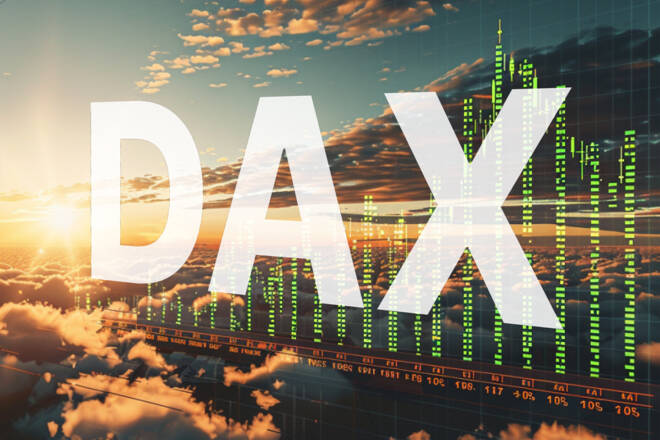Advertisement
Advertisement
DAX Index News: German GDP Revision on Tuesday Could Bolster Rate Cut Hopes
By:
Key Points:
- On Monday, the DAX slipped by 0.09% as German business sentiment weakens and ECB tempers rate cut expectations for September.
- Final German GDP data for Q2 could influence rate cut bets and drive demand for DAX stocks on Tuesday.
- US consumer confidence could shift market sentiment on DAX.
Market Overview
On Monday, August 26, the DAX slipped by 0.09%, partially reversing a 0.76% gain from the previous day, closing at 18,617.
Key DAX Market Movers on Friday
Qiagen slid by 2.37%, with Bayer declining by 1.15% as risk sentiment waned on Monday.
Auto stocks also struggled, with Volkswagen and Daimler Truck Holding declining by 0.23% and 0.09%, respectively.
ECB Chief Economist Lane Tempers ECB Rate Cut Bets
ECB Chief Economist Philip Lane cooled expectations of a September ECB rate cut, impacting demand for DAX-listed stocks. Lane reportedly said,
“The return to target is not yet secure. The monetary stance will have to remain in restrictive territory for as long as needed to shepherd the disinflation process toward a timely return to the target.”
Lane’s comments set the tone for the Monday session, leading to early losses for the DAX.
German Business Sentiment Weakens
German business sentiment trends also influenced ECB rate cut bets. On Monday, August 26, the Ifo Business Climate Index fell from 87.0 in July to 86.6 in August. Businesses assessed their current situation more negatively and became more pessimistic about the outlook.
Mario Cagaggioni, a Senior Portfolio Manager at Fedesa SAM, commented on the sentiment figures, saying,
“IFO beats expectations but is lower than July, confirming a fragile economic activity is underway… I think that ECB growth projection is too high and they need to cut more than forecasted by GC!”
German Economy in the Spotlight
Finalized German GDP numbers for Q2 will draw investor interest on Tuesday, August 27. According to the preliminary report, the German economy contracted by 0.1% in Q2 2024 after expanding by 0.2% in Q1 2024.
A downward revision to GDP numbers could bolster investor bets on a September rate cut, possibly boosting demand for DAX-listed stocks.
Eurozone Economy and ECB Rate Path
Brookings Institute Senior Fellow Robin Brooks stated,
“The global economy is clearly weakening. Germany is one of the world’s biggest exporters. Its new export orders in the flash PMI for August 2024 fell very sharply and is approaching levels in late 2022 right after Russia invaded Ukraine. The Euro zone is heading for a double dip.”
US Manufacturing Sector Shows Resilience
On Monday, better-than-expected manufacturing sector data eased fears of a US recession.
Durable goods orders rose by 9.9% in July, rebounding from a 6.9% decline in June.
Additionally, the Dallas Fed Manufacturing Index increased from -17.5 in July to -9.7% in August, with higher wages a possible boost for the US economy. Higher wages may indicate a stable labor market and an upward trend in consumer spending, which contributes over 70% to GDP.
The better-than-expected numbers reduced expectations of a 50-basis point September Fed rate cut. According to the CME FedWatch Tool, the probability of a 50-basis point rate cut in September dropped from 36.0 on Friday, August 23, to 28.5 on Tuesday, August 26.
US Market Trends
On Monday, the Nasdaq Composite Index and the S&P 500 declined by 0.85% and 0.32%, respectively, while the Dow gained 0.16%.
Investor caution ahead of NVIDIA’s (NVDA) earnings report left the Nasdaq and S&P 500 in negative territory.
US Economic Calendar
US consumer confidence will be in the spotlight on Friday. Economists predict the CB Consumer Confidence Index to drop from 100.3 in July to 100.1 in August.
A larger-than-expected fall in confidence and rising concerns about the labor market could retrigger fears of a US recession.
Recessionary jitters may support bets on more aggressive Fed rate cuts and impact buyer demand for DAX-listed stocks.
Near-Term Outlook
Upcoming inflation data from Germany on Thursday and the US Personal Income and Outlays Report on Friday will likely influence near-term DAX trends.
Weaker inflation numbers and a fall in US personal spending could bolster expectations of September ECB and Fed rate cuts. Increasing expectations of September rate cuts could push the DAX toward 19,000. However, US economic recession jitters could send the DAX below 18,000.
In the futures markets, the DAX and the Nasdaq Mini were up by 26 and 12 points, respectively.
Investors should stay alert, with central bank speakers and economic indicators likely to influence risk sentiment. Monitor the news wires, the economic calendar, and expert commentary to manage trading strategies.
Stay informed with our latest news and analysis to manage your risks effectively.
DAX Technical Indicators
Daily Chart
The DAX hovered above the 50-day and 200-day EMAs, affirming bullish price signals.
A return to 18,750 could give the bulls a run at the all-time high of 18,893. Furthermore, a breakout from $18,893 could signal a move to 19,000.
German and US data and central bank speeches require consideration.
Conversely, a drop below 18,500 could signal a fall toward the 50-day EMA. A fall through the 50-day EMA could bring 18,000 into view.
The 14-day RSI at 62.63 suggests a move to the all-time high of 18,893 before entering overbought territory.
About the Author
Bob Masonauthor
With over 28 years of experience in the financial industry, Bob has worked with various global rating agencies and multinational banks. Currently he is covering currencies, commodities, alternative asset classes and global equities, focusing mostly on European and Asian markets.
Did you find this article useful?
Latest news and analysis
Advertisement
